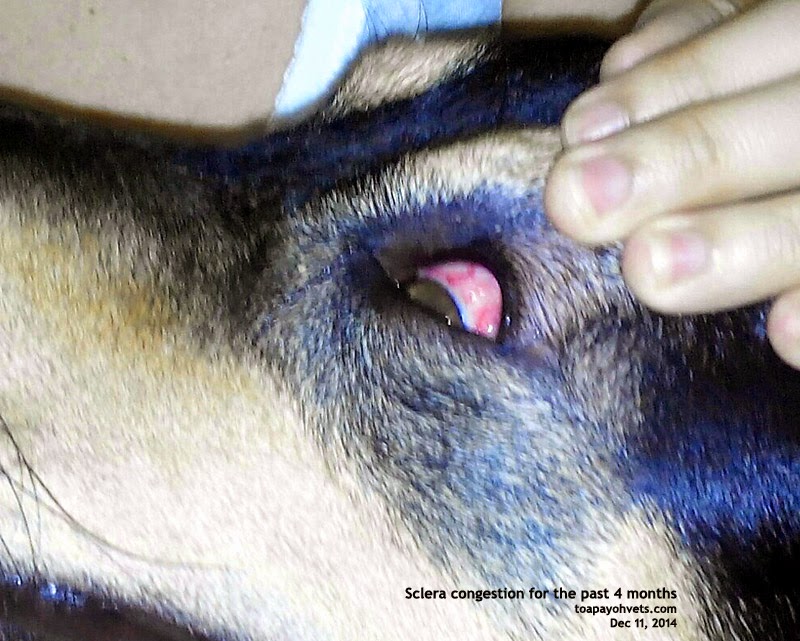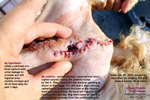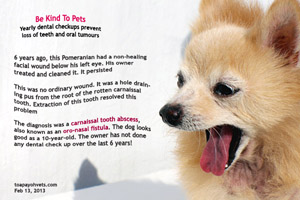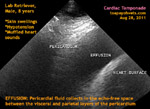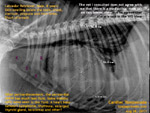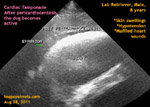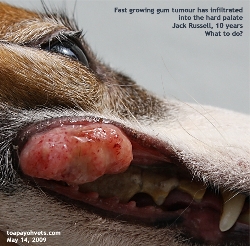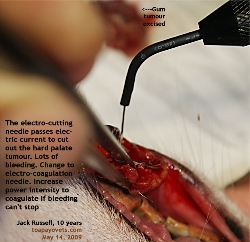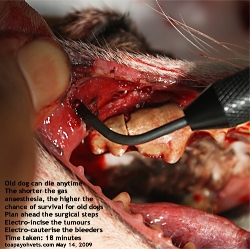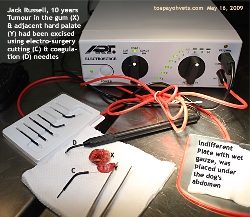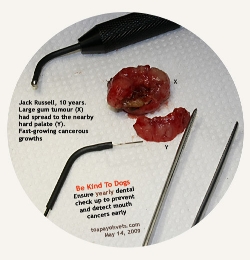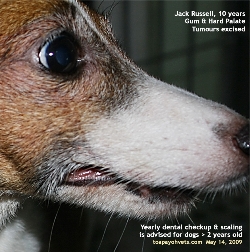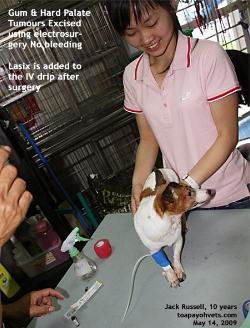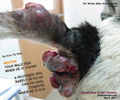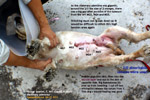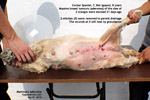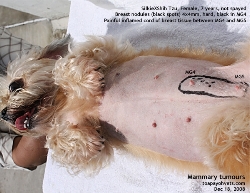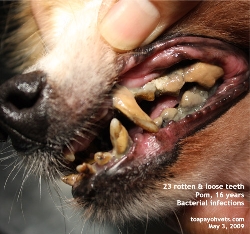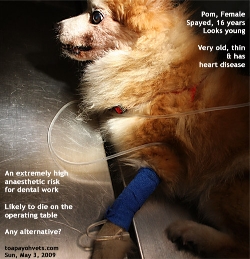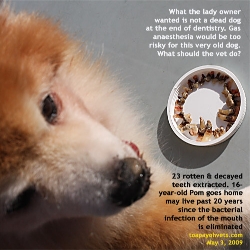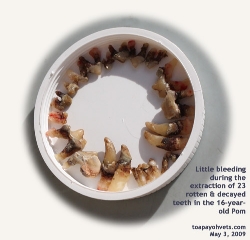If heart disease is diagnosed, the owner has to give the medicine diligently if she wants her beloved old dog to live long. Otherwise, the coughing recurs and the dog dies from heart failure.
Effective dosage is the key to success. This is done by observation of no coughing with minimal dosage and regular timing of medication. You cannot just forget one day or two.
An example of effective dosage is this 15-year-old dog.
Every 2 weeks, the lady would come for the medication which is:
Body weight 19 kg.
Vetmedin 5mg x 14 (1/2 twice a day)
Fortekor 20mg x7 (1/2 once a day)
Fursemide 40mg x28 (1 twice a day).
The dog is active and she is so happy.
-------------------
Treatment
1. Vetmedin. Congestive heart failure originating from valvular insufficiency or dilated cardiomyopathy in dogs.
2. Fortekor. Heart failure due to mitral regurgitation (endocardiosis) and dilated cardiomyopathy and chronic kidney disease in dog.
Frusemide 1-4mg/kg orally to clear fluid from the lungs as a diuretic
Calculated dosage
1. Vetmedin 0.2 to 0.6 mg/kg/day (half dose in morning and the other half 12 hours later).
In this 19 kg dog, the dosage should be 3.8 mg to 11.4 mg/ divided in 50% 2 x /day
2. Fortekor 0.25 - 0.5 mg/kg once daily with or without food.
In this 19 kg dog, the dosage should be 4.75mg - 9.5mg once a day.
3. Frusemide 1-4mg/kg orally to clear fluid from the body as a diuretic
In this 19 kg dog, the dosage should be 19 mg - 76 mg once a day.
Effective dosage in this 19kg dog after 2 months of trial and error:
Body weight 19 kg.
Vetmedin 5mg x 14 (1/2 twice a day) ie. 5 mg divided into 50% of 2 doses 2x/day
Fortekor 20mg x7 (1/2 once a day) ie. 10 mg/once/day
Fursemide 40mg x28 (1 twice a day). 40 mg 2x/day
CASE 2
There is another old coughing Chihuahua with congestive heart failure and abandoned by his owner who went to Thailand and now adopted by a young couple, doing well with the above-mentioned drugs for several months. Able to eat and no coughing. Once the drugs are not given, coughing recurs. Some cases may need injections to stabilise. Coughing affects the caring owner as the nocturnal cough can be quite stressful for the dog and owner.
Wednesday, December 10, 2014
4. Red eyes in dogs
Email from Philipines Dec 8, 2014


http://www.bekindtopets.com/dogs/200912003Shingles_Dog_Attack_ToaPayohVets.htm
-----------------------------------------------------------------------------------------------------------------
REPRINT OF THE ARTICLE
This dog owner in her 50s with 2 children is one of those natural story tellers. She not only could tell stories very well but the way she acted and told it was a master performance.
"I was alone in the house when the 2nd attack occurred," she said when I asked about her two domestic workers. "I rolled up a carpet, pick up XXX (the dog being attacked). Yet TTT held onto the left ear and chin of her sibling till gravity pulled TTT down to earth.
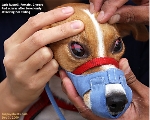
"Did TTT bite you?" I asked.
"No, she growled at me." the woman said. "That is why I boarded TTT
at your Surgery after the attack." TTT sounded like a ferocious Jack Russell and I took precautions of muzzling TTT for examination after the attack. Today was some 2 weeks later. The lady had now diagnosed shingles infection linked to the dog attack, according to her diagnosis. This is what she said to me.
"Two days after the attack, I saw a circle of 'insect bites' on my right lower elbow area." She displayed her wounds on the inner side of her elbow joint. They were now maroon red with a black centre in the bigger wound.
"Are you sure that the circular line of wounds were not caused by TTT biting you?"
This would be my first diagnosis although I am not a medical doctor.
"Well, TTT's teeth was sunk into XXX's left ear. I held XXX up till TTT had to let go as gravity pulled her downwards. So, she could not have bitten me."
The lady waved her hand up and down to show that she had held XXX high up, until TTT gave up to the forces of gravity and dropped to the ground.
"The next day, I felt tired," the lady continued. "Tingling sensations rippled from under the skin of my right elbow to my back shoulder", she pointed to her back. "More rashes appeared in the area. Watery blisters formed. The tingling sensation was unbearable. I quickly went to consult Dr Thiru, the famous skin specialist. Do you know him?"
"I don't know him nor have I met him," I said. "Is he the distinguished looking man with silvery grey hair and white sideburns?" I had attended a talk given by Attorney General Walter Woon's lecture "Criminal Aspects Of Medical Practice" to a full house of at least 1,000 doctors and lawyers in the Supreme Court Auditorium on Nov 30, 2009. The moderator was a doctor who is a skin specialist. "Yes," she confirmed my description of the good doctor.
"The doctor asked whether I had been to the vet?" the woman commented. "Probably my doctor was thinking that my right elbow I had been infected at your Veterinary Surgery."
I don't think the good doctor would have thought that she was infected by putting her elbow on the veterinary examination table and got infected by Shingles. I don't know why he asked whether she had visited the vet earlier.
"So, did he prescribe you the antiviral drug?" I was more interested on the cure.
"He said to wait 3 days," the woman replied. "Then more rashes appeared. They become watery and burst. I felt tingling, as if some snakes were travelling up my hand to behind my back and forth. I quickly went to see him. He was not available but his colleague gave me the medication. Now I feel so much better and have the time to quickly get my 2 dogs vaccinated."
"My sister had shingles." I said. "The viruses travelled along her nerves in her leg and the serpentine lesion manifested as snake-like in appearance."
This woman did not have the serpentine tracks as she had sought prompt medical treatment. "If the virus completes the travel from one end of the nerve, go round the body, the person will die," the lady told me about a common Chinese belief. "That is why the Chinese temple medium used incense to burn the shingles skin. To kill off the head of the snake."
"Some Singapore people don't know what is the cause of this serpentine skin problem," I said. "So, they seek the help of Chinese mediums."
The lady enlightened me: "Actually, shingles is the re-activation of the chicken pox virus due to stress. The virus lurks in the body for a lifetime. It is extremely painful, itchy and causes tingling sensations."
This lady is surely knowledgeable about shingles. I just could not believe that separating two dogs in a fight would lead to a shingle infection as this lady was definitely in good health. I believe that there is a remote possibility that TTT had bitten her right elbow when the dog loosened her grip on XXX and was falling down to earth. I mean, how would the lady know since she was highly agitated and in that instant, TTT's bite would have resulted in what she first told me as "circular rashes" in a small area in the inner aspect of the skin of her right elbow. I remembered asking her to repeat what she said. She said "circular rashes".
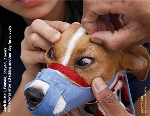 She
meant that she had rashes clustered in a circle. Or semi-circle. The
pain and tingling sensations could be due to the spread of
micro-organisms along the nerve and tissues originating from the
bite wounds. This condition is documented in the skin to owners
owners who had been scratched by the cat.
She
meant that she had rashes clustered in a circle. Or semi-circle. The
pain and tingling sensations could be due to the spread of
micro-organisms along the nerve and tissues originating from the
bite wounds. This condition is documented in the skin to owners
owners who had been scratched by the cat.
These bite rashes from the upper and lower incisor teeth of the attacking dog would become infected. That could be the reason that the first doctor did not think this was a shingles infection. As for the appearances of more rashes in the surrounding area, it could be due to the scratching of the infected skin. This is my hypothesis which I am sure the lady would not agree. I have not seen shingle infections in human beings. Maybe they manifest as rashes clustered in the circle too.
Medicine is full of diagnostic mysteries. I asked to see the inner or medial aspect of the elbow again. I could see that the rashes covering an area of 10 X 10 cm of skin in the elbow. The biggest rash was 8 mm in diameter. It had a black centre. Other rashes were healing.
This is an incredible but true story of an apparent shingles infection linked to dog assault. Did the attacking dog get any shingles as well? She had really blood shot eyes. Red sclera in both eyes after her ferocious lunge for the jugular of the sibling who garnered more attention at home. The redness in both sleras persisted for several days. So, would this be caused by a virus activated by the high stress of trying to get rid of the rival in love? A latent herpes
zoster-equivalent virus in the dog, a canine type of chicken pox
virus that gets reawakened in times of high stress? This dog was
lunging for the jugular of the sibling with only one intention. To
kill a rival in who is favoured
more by family members. But her attempt was thwarted and
now she was "in the doghouse". Or to be precise, waiting to be
rehomed (
herpes
zoster-equivalent virus in the dog, a canine type of chicken pox
virus that gets reawakened in times of high stress? This dog was
lunging for the jugular of the sibling with only one intention. To
kill a rival in who is favoured
more by family members. But her attempt was thwarted and
now she was "in the doghouse". Or to be precise, waiting to be
rehomed (
P.S.
1. Herpes zoster (Shingles). Anybody who has had chicken pox is at risk for developing shingles many years later. The chicken pox virus lies dormant in the person's body. Stress or a decreased immune system reawakens the virus, resulting in shingles infection. It appears as a rash. Rashes cluster around the eyes, face or body. The Shingles infection is also called herpes zoster. It is an extremely painful and itchy condition. Early aggressive treatment with antiviral drugs can lessen the length and severity of shingles attack.
2. Red scleras in the dog. I had encountered a few cases. Some are due to traumatic injuries. Some are a result of intense rubbing of the eye arising from some chemical spills. I note that there is a dog owner posting a picture of his dog with red sclera in a local website called Stomp.
I had 2 memorable cases of red scleras in Jack Russells.
2.1 This Jack Russell had a chew rope stuck inside its colon for some time.
2.2 This Jack Russell had intense abdominal pain and was vomiting. Exploratory laporatomy revealed petechial haemorrhages in the pancreas.
This present case would make it 3 memorable cases of Jack Russells with blood-shot eyes. E-mail to judy@toapayohvets.com if you have seen more cases.
Dec 8 (3 days ago)
 | |||
| |||
My
dog's sclera has bloodshots and turns red specially at night. In the
morning its not that red. I dont know whats causing it. :(
REPLY FROM DR SING DEC 8, 2014
Pl send two images of the red sclera and eye involved..
3 IMAGES SENT
Sorry I couldn't get a clear photo. Attached are photos of his right
eye. It started on his red eye May (2014) this year. He's been on
different eye drops since then but nothing really helped. Now his left
eye are showing signs of bloodshots too. At first i thought it was
glaucoma but it's not. Vets here are also clueless as to whats causing
it.
EMAIL FROM DR SING DEC 9, 2014
Any image of lower half of sclera?
Im having a hard time taking pics of the lower part of his
sclera but right now its not red but it has blood shots as well. Thin
ones.
Are you a Vet? Where are u from? I just came across an
article online so i decided to email you. Im hope im not so much of a
bother. Its just that im worried about my dog I dont want him to go
blind. Ive already brought him to an animal hospital here in my country
but they also dont know whats causing it.
Thank you..
EMAIL REPLY FROM DR SING DEC 10, 2014
Yes, I am a vet, Dr Sing Kong Yuen from www.toapayohvets.com
Which article you saw online? Which animal hospital and which country you are in?
Good morning doctor!
I think its your rticle about red sclera. I've been
searching the internet of anything that could help me figure out whats
causing the redness and bloodshots in my dog's right eye when i came
across your article.
I brought my dog to vip hospital (vets in practice) already
and recently in Animal House hospital here in the Philippines. But they
can't figure out whats causing it. Accdg to them his eyes seem normal
other than the redness and bloodshots of the sclera.
He's been on diff eye drops, ointments, steroids.. His eye
improved but the sclera is still the same. His blood test results are all
okay. His blood pressure is high so but even after giving him meds for
hypertension his eye didnt improve.
If you have any idea as to whats causing i hope you can help me.. Thank youuu so much. :)
Your article is at:
Your article is at:
http://www.bekindtopets.com/dogs/200912003Shingles_Dog_Attack_ToaPayohVets.htm
-----------------------------------------------------------------------------------------------------------------
REPRINT OF THE ARTICLE
This dog owner in her 50s with 2 children is one of those natural story tellers. She not only could tell stories very well but the way she acted and told it was a master performance.
"I was alone in the house when the 2nd attack occurred," she said when I asked about her two domestic workers. "I rolled up a carpet, pick up XXX (the dog being attacked). Yet TTT held onto the left ear and chin of her sibling till gravity pulled TTT down to earth.

"Did TTT bite you?" I asked.
"No, she growled at me." the woman said. "That is why I boarded TTT
at your Surgery after the attack." TTT sounded like a ferocious Jack Russell and I took precautions of muzzling TTT for examination after the attack. Today was some 2 weeks later. The lady had now diagnosed shingles infection linked to the dog attack, according to her diagnosis. This is what she said to me.
"Two days after the attack, I saw a circle of 'insect bites' on my right lower elbow area." She displayed her wounds on the inner side of her elbow joint. They were now maroon red with a black centre in the bigger wound.
"Are you sure that the circular line of wounds were not caused by TTT biting you?"
This would be my first diagnosis although I am not a medical doctor.
"Well, TTT's teeth was sunk into XXX's left ear. I held XXX up till TTT had to let go as gravity pulled her downwards. So, she could not have bitten me."
The lady waved her hand up and down to show that she had held XXX high up, until TTT gave up to the forces of gravity and dropped to the ground.
"The next day, I felt tired," the lady continued. "Tingling sensations rippled from under the skin of my right elbow to my back shoulder", she pointed to her back. "More rashes appeared in the area. Watery blisters formed. The tingling sensation was unbearable. I quickly went to consult Dr Thiru, the famous skin specialist. Do you know him?"
"I don't know him nor have I met him," I said. "Is he the distinguished looking man with silvery grey hair and white sideburns?" I had attended a talk given by Attorney General Walter Woon's lecture "Criminal Aspects Of Medical Practice" to a full house of at least 1,000 doctors and lawyers in the Supreme Court Auditorium on Nov 30, 2009. The moderator was a doctor who is a skin specialist. "Yes," she confirmed my description of the good doctor.
"The doctor asked whether I had been to the vet?" the woman commented. "Probably my doctor was thinking that my right elbow I had been infected at your Veterinary Surgery."
I don't think the good doctor would have thought that she was infected by putting her elbow on the veterinary examination table and got infected by Shingles. I don't know why he asked whether she had visited the vet earlier.
"So, did he prescribe you the antiviral drug?" I was more interested on the cure.
"He said to wait 3 days," the woman replied. "Then more rashes appeared. They become watery and burst. I felt tingling, as if some snakes were travelling up my hand to behind my back and forth. I quickly went to see him. He was not available but his colleague gave me the medication. Now I feel so much better and have the time to quickly get my 2 dogs vaccinated."
"My sister had shingles." I said. "The viruses travelled along her nerves in her leg and the serpentine lesion manifested as snake-like in appearance."
This woman did not have the serpentine tracks as she had sought prompt medical treatment. "If the virus completes the travel from one end of the nerve, go round the body, the person will die," the lady told me about a common Chinese belief. "That is why the Chinese temple medium used incense to burn the shingles skin. To kill off the head of the snake."
"Some Singapore people don't know what is the cause of this serpentine skin problem," I said. "So, they seek the help of Chinese mediums."
The lady enlightened me: "Actually, shingles is the re-activation of the chicken pox virus due to stress. The virus lurks in the body for a lifetime. It is extremely painful, itchy and causes tingling sensations."
This lady is surely knowledgeable about shingles. I just could not believe that separating two dogs in a fight would lead to a shingle infection as this lady was definitely in good health. I believe that there is a remote possibility that TTT had bitten her right elbow when the dog loosened her grip on XXX and was falling down to earth. I mean, how would the lady know since she was highly agitated and in that instant, TTT's bite would have resulted in what she first told me as "circular rashes" in a small area in the inner aspect of the skin of her right elbow. I remembered asking her to repeat what she said. She said "circular rashes".
 She
meant that she had rashes clustered in a circle. Or semi-circle. The
pain and tingling sensations could be due to the spread of
micro-organisms along the nerve and tissues originating from the
bite wounds. This condition is documented in the skin to owners
owners who had been scratched by the cat.
She
meant that she had rashes clustered in a circle. Or semi-circle. The
pain and tingling sensations could be due to the spread of
micro-organisms along the nerve and tissues originating from the
bite wounds. This condition is documented in the skin to owners
owners who had been scratched by the cat. These bite rashes from the upper and lower incisor teeth of the attacking dog would become infected. That could be the reason that the first doctor did not think this was a shingles infection. As for the appearances of more rashes in the surrounding area, it could be due to the scratching of the infected skin. This is my hypothesis which I am sure the lady would not agree. I have not seen shingle infections in human beings. Maybe they manifest as rashes clustered in the circle too.
Medicine is full of diagnostic mysteries. I asked to see the inner or medial aspect of the elbow again. I could see that the rashes covering an area of 10 X 10 cm of skin in the elbow. The biggest rash was 8 mm in diameter. It had a black centre. Other rashes were healing.
This is an incredible but true story of an apparent shingles infection linked to dog assault. Did the attacking dog get any shingles as well? She had really blood shot eyes. Red sclera in both eyes after her ferocious lunge for the jugular of the sibling who garnered more attention at home. The redness in both sleras persisted for several days. So, would this be caused by a virus activated by the high stress of trying to get rid of the rival in love? A latent
 herpes
zoster-equivalent virus in the dog, a canine type of chicken pox
virus that gets reawakened in times of high stress? This dog was
lunging for the jugular of the sibling with only one intention. To
kill a rival in who is favoured
more by family members. But her attempt was thwarted and
now she was "in the doghouse". Or to be precise, waiting to be
rehomed (
herpes
zoster-equivalent virus in the dog, a canine type of chicken pox
virus that gets reawakened in times of high stress? This dog was
lunging for the jugular of the sibling with only one intention. To
kill a rival in who is favoured
more by family members. But her attempt was thwarted and
now she was "in the doghouse". Or to be precise, waiting to be
rehomed (
P.S.
1. Herpes zoster (Shingles). Anybody who has had chicken pox is at risk for developing shingles many years later. The chicken pox virus lies dormant in the person's body. Stress or a decreased immune system reawakens the virus, resulting in shingles infection. It appears as a rash. Rashes cluster around the eyes, face or body. The Shingles infection is also called herpes zoster. It is an extremely painful and itchy condition. Early aggressive treatment with antiviral drugs can lessen the length and severity of shingles attack.
2. Red scleras in the dog. I had encountered a few cases. Some are due to traumatic injuries. Some are a result of intense rubbing of the eye arising from some chemical spills. I note that there is a dog owner posting a picture of his dog with red sclera in a local website called Stomp.
I had 2 memorable cases of red scleras in Jack Russells.
2.1 This Jack Russell had a chew rope stuck inside its colon for some time.
2.2 This Jack Russell had intense abdominal pain and was vomiting. Exploratory laporatomy revealed petechial haemorrhages in the pancreas.
This present case would make it 3 memorable cases of Jack Russells with blood-shot eyes. E-mail to judy@toapayohvets.com if you have seen more cases.
Saturday, December 6, 2014
3. How your elderly dog can live longer?
| ||||||||||||||||||||||||||||||||||||
| ||||||||||||||||||||||||||||||||||||
Monday, November 10, 2014
How to take good care of your red-eared slider terrapin
TERRAPINS
1. Don't overfeed. Too much protein or phosphorus. Variety of food.
2. Don't underfeed. Picky terrapins. Variety including meal worms, fish, vegetables, shrimps from pet shops.
3. Don't use gravel. Rough causing shell injuries. Eaten causing intestinal impaction.
Smooth pebbles.
4. Inadequate basking area. Need to dry completely. A 2-in-one UVB and heating lamp will be best. Basking area 85-92 deg F. Cannot thermo-regulate. So need warmth. Prevent shell rot or algae. Shell health important. No obstruction to UVB light to terrapins by objects.
5. Don't pull off shedding scutes as new shell is growing. May cause shell rot. Let shedding come off unless too long to fall off. Consult vet.
6. Water quality. Chlorine causes resp. problems. Healthy terrapins eat and poop a lot. Good canister filtration. Change water weekly. Plants to break down ammonia and nitrates.
7. Escaping turtles. Like to climb out of tank over objects. Prevent cat and dog visit or trauma.
8. Salmonella from terrapins (carriers of Salmonella in poo, no signs) to people. Wash hands.
9. Don't release captives in the wild.
http://2010vets.blogspot.sg/2013/03/1331-images-used-for-caring-for-your.html
http://2010vets.blogspot.sg/2013/02/1279-swollen-eyes-in-two-terrapins.html
http://2010vets.blogspot.sg/2014/09/1499-4-year-old-terrapin-has-swollen.html
Metaplasia of the terrapin's eyes
http://2010vets.blogspot.sg/2013/01/1267-metaplasia-of-terrapins-eyes.html
Ear abscess in a terrapin
http://2010vets.blogspot.sg/2014/01/the-lady-who-googled-ear-abscess.html
Turtles webpage of Toa Payoh Vets
http://www.asiahomes.com/singaporepets/20130131turtles_ToaPayohVets.htm
A moaning terrapin
http://www.sinpets.com/F5/20120919red_eared_slider_moans_toapayohvets.htm
Cheek ulcer in a terrapin, Gasping.
https://www.youtube.com/watch?v=OyfgbGNAFVQ&feature=youtu.be
Monday, October 27, 2014
1. How to minImise anaesthetic death in an old dog
1. How to minmise anaesthetic death in an old dog
Informed consent
History and physical examination
Blood test, ECG and X-rays
Sedation dosage 50% for dogs over 5 years old or not as healthy
Antidote to sedation
Emergency drugs
IV drip, antibiotics and diuretic
Intubation
Duration of anaesthesia
Close monitoring of anaesthesia by experienced assistant
Duration of surgery
Antidote
Recovery. Not to go home immediately
Post op antibiotics and painkillers for extracted teeth
Oct 28, 2014. A father and young adult daughter presented this gentle 7-year-old male Sheltie for dental scaling. A friend's Maltese had died after dental scaling by another vet and so the owners were worried about anaesthetic death. "Dogs usually do not die under anaesthesia or after anaesthesia," I said to the father. "Unless the dog has heart disease or poor health."
A thorough physical examination showed that this Sheltie with bad breath was generally healthy in heart and lungs. The heart beats were irregular. 50% sedation of domitor and ketamine IV calmed this nervous Sheltie.
Health screening including a complete cell count and X-rays of the chest is advised. No ECG is done.
In this case, I gave an IV drip, with IV baytril, frusemide and Vit B complex.
It is very important to provide a very close monitoring of the maintenance of isoflurane gas at 0-2%, oxygen flow rate at 2 litres/minute to ensure that minimal anaesthesia is being given. The dog did wake up in the midst of dental scaling as the maintenance dose was 0.5%.
He was intubated again and maintained at 2%. The dog woke up fast and went home 3 hours later. Follow up 2 days later showed that the dog is OK. The dog had been given dry dog food and milk since young. He likes only certain brands of milk. Well beloved family dog and in excellent body condition.
FOLLOW UP
Oct 28, 2014
A new client - father and young adult daughter brought in a 7-year-old male entire Shetland for dental scaling. Their friend's Maltese had died after dental scaling in another vet practice and so they did not want to go to the practice.
"Very rarely do dogs die after waking up from anaesthesia given for dental scaling," I said. "Was the Maltese having heart diseases?" The owners of the gentle full sized Sheltie did not know but they would avoid this friend's vet
No vet can guarantee no anaesthetic risk. Even people do die.
PHYSICAL EXAMINATION
Other than periodontal disease grade 4 (tissue attachment loss over 50%), I noted that this Sheltie had congested maroon red gums, not the normal pink ones. You can see this in the video. Why? The capillary refill time was longer than the usual 2 seconds. Blood test showed that this dog had a higher than normal amount of haemoglobin in his blood at 19.1 (12-18). The total red cell count was normal. The haematocrit was normal too. Platelets were normal. What does it mean? Was he fed some supplements?
BLOOD TEST on 27.10.14 Abnormal values
Urea 12.3 (4.2 - 6.3)
Creatiine 65 (89-177)
Haemoglobin 19.1 (12-18)
All the other blood values within normal limits.
FOLLOW UP - Day 2 after dental scaling
The dog was a bit tired yesterday but is Ok and eating today.
"Tartar started to build up fast in last 3 years," the father said that the dog was not given meat. "Could it be the milk making the kibbles soft?". This dog had the biggest crusty tartar I had ever seen in a dog (see image/video).
The dry dog food was Science Diet Lamb and Rice with a brand of dog's milk since young. Dog treats were given.
ADVICES 2 DAYS LATER
No milk and treats to prevent tartar build up.
Eat dry food without milk and drink water.
Blood test 4 weeks later to check on the urea levels.
This case shows that a blood test is important for screening the health of an older dog. The owner was given the option. The blood test was done by me as this dog had an unusual congested gums.
-------------------------------------------------------------------------------------------------------
| DENTAL WORK WITHOUT ANAESTHESIA IN A VERY OLD POMERANIAN WITH HEART DISEASES Dr Sing Kong Yuen, BVMS (Glasgow), MRCVS Written: 04 September, 2010 |  toapayohvets.com toapayohvets.com Be Kind To Pets Veterinary Education Project 2010-0129 | ||||||||||||||||||||||||||
| |||||||||||||||||||||||||||
Subscribe to:
Comments (Atom)

